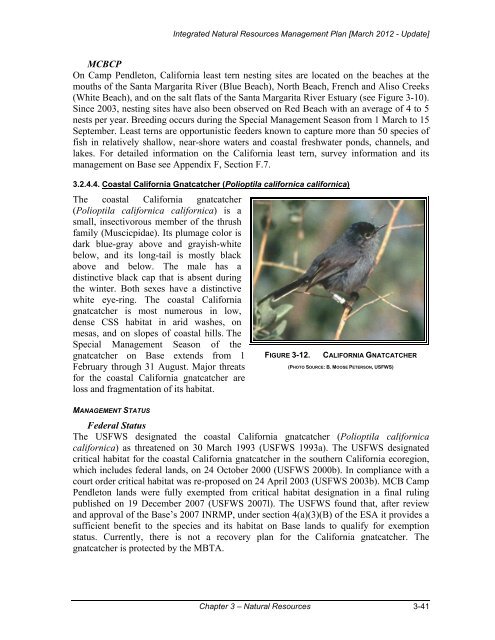Chapter 3 - Natural Resources - Marine Corps Base Camp Pendleton
Chapter 3 - Natural Resources - Marine Corps Base Camp Pendleton
Chapter 3 - Natural Resources - Marine Corps Base Camp Pendleton
You also want an ePaper? Increase the reach of your titles
YUMPU automatically turns print PDFs into web optimized ePapers that Google loves.
Integrated <strong>Natural</strong> <strong>Resources</strong> Management Plan [March 2012 - Update]<br />
MCBCP<br />
On <strong>Camp</strong> <strong>Pendleton</strong>, California least tern nesting sites are located on the beaches at the<br />
mouths of the Santa Margarita River (Blue Beach), North Beach, French and Aliso Creeks<br />
(White Beach), and on the salt flats of the Santa Margarita River Estuary (see Figure 3-10).<br />
Since 2003, nesting sites have also been observed on Red Beach with an average of 4 to 5<br />
nests per year. Breeding occurs during the Special Management Season from 1 March to 15<br />
September. Least terns are opportunistic feeders known to capture more than 50 species of<br />
fish in relatively shallow, near-shore waters and coastal freshwater ponds, channels, and<br />
lakes. For detailed information on the California least tern, survey information and its<br />
management on <strong>Base</strong> see Appendix F, Section F.7.<br />
3.2.4.4. Coastal California Gnatcatcher (Polioptila californica californica)<br />
The coastal California gnatcatcher<br />
(Polioptila californica californica) is a<br />
small, insectivorous member of the thrush<br />
family (Muscicpidae). Its plumage color is<br />
dark blue-gray above and grayish-white<br />
below, and its long-tail is mostly black<br />
above and below. The male has a<br />
distinctive black cap that is absent during<br />
the winter. Both sexes have a distinctive<br />
white eye-ring. The coastal California<br />
gnatcatcher is most numerous in low,<br />
dense CSS habitat in arid washes, on<br />
mesas, and on slopes of coastal hills. The<br />
Special Management Season of the<br />
gnatcatcher on <strong>Base</strong> extends from 1<br />
February through 31 August. Major threats<br />
for the coastal California gnatcatcher are<br />
loss and fragmentation of its habitat.<br />
FIGURE 3-12.<br />
CALIFORNIA GNATCATCHER<br />
(PHOTO SOURCE: B. MOOSE PETERSON, USFWS)<br />
MANAGEMENT STATUS<br />
Federal Status<br />
The USFWS designated the coastal California gnatcatcher (Polioptila californica<br />
californica) as threatened on 30 March 1993 (USFWS 1993a). The USFWS designated<br />
critical habitat for the coastal California gnatcatcher in the southern California ecoregion,<br />
which includes federal lands, on 24 October 2000 (USFWS 2000b). In compliance with a<br />
court order critical habitat was re-proposed on 24 April 2003 (USFWS 2003b). MCB <strong>Camp</strong><br />
<strong>Pendleton</strong> lands were fully exempted from critical habitat designation in a final ruling<br />
published on 19 December 2007 (USFWS 2007l). The USFWS found that, after review<br />
and approval of the <strong>Base</strong>’s 2007 INRMP, under section 4(a)(3)(B) of the ESA it provides a<br />
sufficient benefit to the species and its habitat on <strong>Base</strong> lands to qualify for exemption<br />
status. Currently, there is not a recovery plan for the California gnatcatcher. The<br />
gnatcatcher is protected by the MBTA.<br />
<strong>Chapter</strong> 3 – <strong>Natural</strong> <strong>Resources</strong> 3-41

















